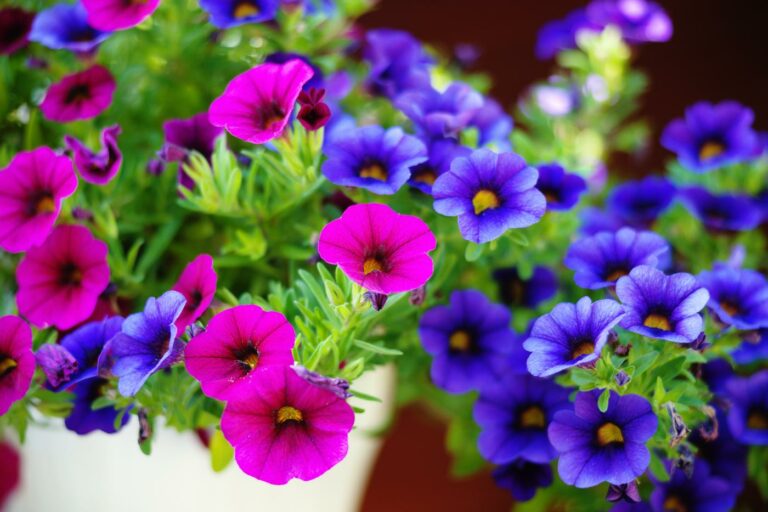Petunias are a fantastic addition to any garden, with their colorful blooms and ease of care. They come in a wide variety of shades, from classic pinks and purples to bold yellows and oranges, so you’re sure to find a color that suits your taste.
These versatile plants – just like Dahlias – are great for adding pops of color to flower beds, borders, and hanging baskets. They also attract pollinators such as bees and butterflies, which is always a plus for any garden.
What’s more, petunias are easy to care for, making them a perfect choice for beginners and busy gardeners alike. They thrive in full sun and well-drained soil, and only need occasional watering and fertilizing to keep them looking their best.
Most common Petunia varieties:
- Limelight (Petunia x hybrida ‘Limelight’)
- Fortunia Early Blue Vein (Petunia x hybrida ‘Fortunia Early Blue Vein’)
- Cascadias Rim Magenta (Petunia x hybrida ‘Cascadias Rim Magenta’)
- Prism Sunshine (Petunia x hybrida ‘Prism Sunshine’)
- Mini Rose Blast Pink (Petunia x hybrida ‘Mini Rose Blast Pink’)
Give it a read

Care
If you’re thinking about adding some petunias to your garden, there are a few things to keep in mind. First of all, petunias (just like the Sunflowers) love the sun, so make sure to give them plenty of it. However, be aware that during hot summers with intense sun, their blooming might temporarily stop.
To keep your petunias happy and healthy, they’ll need regular watering and feeding throughout the growing season, which typically runs from spring to fall. It’s also a good idea to protect them from extreme weather, like heavy rain or scorching sun. You can do this by moving potted petunias to a protected area or setting up a temporary cover over petunias in flower beds.
- Soil: these plants prefer fertile, slightly acidic soil that drains well, so make sure to choose a spot with good drainage. They can grow in different soil types, but the key is to ensure the soil is well-draining to avoid waterlogging the roots.
- Water: You’ll want to make sure they’re getting the right amount of water. A good rule of thumb is to give your petunias a deep soak once a week with 1 to 2 inches of water, especially when there hasn’t been much rainfall. This will keep the soil moist but not too wet. However, keep in mind that some spreading types of petunias and petunias in pots may need more frequent watering to stay hydrated.
- Light: You’ll want to make sure they’re getting the right amount of sunlight. Most petunia varieties prefer full sun, which means at least six hours of direct sunlight on most days. However, during the hot summer months, the strong afternoon sun can be a bit too much for your petunias to handle. If you notice that they’re starting to wilt or the blooms are fading, consider providing some partial shade during the hottest part of the day.
- Temperature: It’s important to keep them in the right temperature range. Ideally, they like temperatures between 60-75°F during the day and 55-65°F at night.
Propagation
If you have a favorite petunia variety that you’d like to cultivate year-round or share with friends, you can propagate it using stem cuttings. This technique involves taking a healthy portion of stem around 6 inches long, removing the lower foliage, dipping the cut end in rooting hormone, and planting it in a small container filled with moistened soilless potting mix.
Place the container in bright, indirect light, keep the soil moist, and in a few weeks, you should see root growth. Fall, prior to any frost, is an ideal time to take cuttings from a healthy plant. By following these steps, you can save and enjoy your favorite petunia variety for years to come!
Pruning
Timing is key when it comes to pruning petunias. You don’t want to do it too early or too late; otherwise, you might upset your lovely flowers. You should prune your petunias lightly every two weeks in the growing season (early July – mid-September).
Check out our Step-by-Step Guide on How to Prune Petunias like a Pro!
Common Pests
Frequently Asked Questions
Petunias prefer full sun, which means they like to receive at least six hours of direct sunlight on most days. However, during the hot summer months, partial shade (especially from the strong afternoon sun) can help to keep them refreshed and blooming better.
What month is best to plant petunias?
The best time to plant petunias will depend on your location and the climate in your area. In general, petunias are warm-season annuals and prefer to be planted after the threat of frost has passed and the soil has warmed up in the spring.
How long do petunias last for?
As annual plants, petunias usually last for one growing season. However, if they are well-cared for, they can continue to bloom and produce new flowers for several months, typically from spring through fall.
Do petunias need a lot of water?
In general, it’s sufficient to soak petunia beds with 1 to 2 inches of water per week if you don’t have rainfall. However, this can vary depending on the weather conditions and the type of petunias you have. Just don’t let them soak in water for long!
Can petunias survive winter?
Petunias are generally sensitive to freezing temperatures and will not survive frost. If the temperature drops below 40°F, petunias will be at risk of damage or death, although some varieties such as the Wave® series can tolerate temperatures as low as 35°F.
